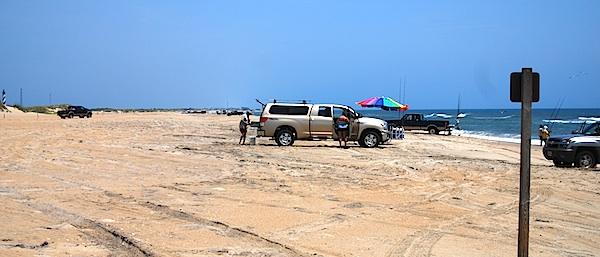
A federal judge has refused to toss out the National Park Service's off-road management plan at Cape Hatteras National Seashore/Kurt Repanshek
In a conclusion that has been reached in many other court cases across the country, a federal court, ruling on a case involving Cape Hatteras National Seashore in North Carolina, has found that resource protection trumps recreational interests. U.S. District Judge Terrence Boyle also found that the National Park Service did not rely on shoddy science when it developed an off-road management plan.
The lawsuit was brought by the Cape Hatteras Access Preservation Alliance, which long has argued that the ORV management plan is too restrictive, a detriment to the local economy on the Outer Banks of North Carolina, and, quite frankly, that the Park Service acted arbitrarily and capraciously. Too, the group charged, the plan runs counter to the national seashore's enabling legislation.
In tackling that last argument first, U.S. District Judge Terrence W. Boyle, ruling last Thursday, wrote that, "While the Seashore's Enabling Act does specifically mention recreational activities, Congress' intent as to the priority of natural resource protection over recreational use on the Seashore is quite plain: no plan for the convenience of visitors should be implemented if it is incompatible with the preservation of the flora and fauna of the Seashore. As CHAPA concedes, the Seashore's Enabling Act and the Organic Act are not in conflict on this issue, and indeed 'over twenty years of federal court decisions confirm that conservation is the predominant facet of the Organic Act.'"
More so, the judge pointed out that, "While CHAPA contends that NPS should have further considered ORV management in areas deemed to be especially adaptable for recreational use, CHAPA has not pointed to nor can the Court identify any basis for such claim. ORV use is not a recreational activity explicitly mentioned in the Seashore's Enabling Act, and the final rule exhibits that the NPS did extensively consider ORV use on the Seashore, as it designates more than twenty-eight miles to year-round ORV driving routes as well as forty-one miles to partial-year ORV use."
Throughout his 23-page ruling Judge Boyle again and again turned back the group's charges, finding that the Park Service did not act capriciously or arbitrarily, did use best available science, and did consider the economic consequences of the various alternatives considered in coming up with the ORV plan.
A holistic analysis of the process reveals that NPS engaged in a careful and detailed study of the Seashore, its wildlife and vegetation, and the visitors and residents who utilize the beaches to arrive at a plan which is based on the factors that Congress intended be considered and was not preordained or afait accompli. CHAPA itself was a party to the consent decree, which was a step toward compliance with Executive Order 11644 and 36 C.F.R. § 4.10 requiring that all ORV use on the Seashore be pursuant to a final rule or special regulation. CHAPA and its members participated fully in the rulemaking process, as is evidenced by the number of comments submitted to and considered by NPS in its formulation of an FEIS and final rule. It is clear from the record in this matter that NPS sufficiently considered all viewpoints when determining how to regulate ORV use on the Seashore, bearing in mind that NEPA evinces a "national policy ... to promote efforts which will prevent or eliminate damage to the environment."
Under the seashore's ORV management plan, areas along the 70-odd miles of beach are either closed, seasonally open, or open year-round to ORV use; the Park Service has been working on developing new parking areas and beach access points along Highway 12, and; a new trail is to be built to allow pedestrians to walk down through the dunes to the beach.
The plan also provides for a "seasonal night-driving restriction ... established from 9 p.m. to 7 a.m. during turtle nesting season, although areas with no turtle nests could open to night driving from September 16 through November 15." Additionally, it calls for an "alternative transportation study and would encourage the establishment of a beach shuttle or water taxi."
Overall, the approved plan allows for 27.9 miles of year-round designated ORV routes on the seashore, 12.7 miles of seasonal routes, and 26.4 miles of vehicle-free miles. The rules also outline vehicle requirements, permit requirements, nightly ORV restrictions, speed limits and more.
Outside of court, an effort has been under way in the Senate to order the National Park Service to reconsider the ORV plan. The measure, S. 486, was sponsored in 2013 by U.S. Sens. Kay Hagan, a Democrat, and Richard Burr, a Republican, both of North Carolina. As initially introduced, the bill would have eliminated the Park Service safeguards for beach-nesting wildlife and pedestrian beachgoers to favor instead trucks on park beaches, according to the National Parks Conservation Association. In committee action, though, Sen. Ron Wyden, D-Oregon, tweaked the measure to require the Park Service to study how wildlife protection measures might be modified to provide more vehicle access while still protecting wildlife and pedestrians. It has not been considered by the full Senate.
Similar legislation (H.R. 2954), though, has passed the House of Representatives.



Comments
Saudi Arabia is less than 10% of our oil consumption and we haven't faught a single war to protect Saudi Arabia. Who is clueless?
Rick - I provided the numbers and their source. Refute them. Tell us how a company paying 48% effective income rate PLUS $66 billion in other taxes is being "subsidized".
No Lee, they don't exist.
OK, we're closing this down. Thanks for your participation.